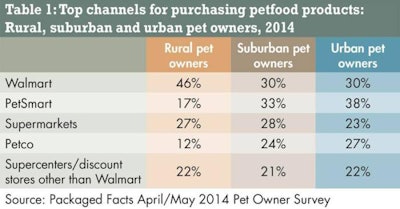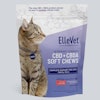
At Petfood Forum 2014, GfK reported an estimate of US$3 billion for petfood sales in 2013 through the US farm/feed store channel. That figure translates to over a tenth of the US$28 billion retail market for petfood, per Packaged Facts’ U.S. Pet Market Outlook 2014–2015.
This attention-worthy segment size follows from two main factors: The rural share of the pet dog and cat population, and the relative levels of petfood spending by rural pet owners.
To gauge the rural share of total pet owners, we can look at Simmons national consumer survey data from Experian Marketing Services, which classifies US counties into four tiers by population density. The fourth tier—comprising the least populated counties—represents in aggregate 15% of total US households, but accounts for a slightly disproportionate 16.6% share of dog owners and 18.7% share of cat owners.
Moreover, rural households skew to multiple pet ownership, accounting for slightly higher shares of pet owners with four or more dogs (17.2%) or four or more cats (19.8%). This skew is understandable enough, given the less crowded conditions in these fourth-tier counties: 30% of pet-owning households in these rural counties own at least two acres of land surrounding the home, compared with 11% of US pet-owning households overall and only 4% of pet households who live in the most populous metro counties.
On the other hand, spending by rural pet owners on pet products skews in the opposite direction. According Packaged Facts’ April/May 2014 Pet Owner Survey, only 25% of pet owners who live in rural areas spend more than US$50 monthly on pet products overall, compared with 35% of urban or suburban pet owners.
The Walmart low pricing retail empire (“Save money. Live better.”) plays into this effect. Our survey data show that 46% of rural pet owners buy petfood at Walmart, compared with 30% of urban or suburban pet owners (see Table 1). Correspondingly, rural pet owners are significantly less likely to shop at pet superstores, which feature a higher percentage of premium and superpremium petfood offerings.
By extension, rural pet owners are significantly less likely than their urban counterparts to use specialty petfood formulations such as organic (at 4% vs. 22%, respectively), grain-free, or non-GMO, or nutraceutical-featuring petfood formulas such as high antioxidant, high omega-3, or high probiotic, or weight management or breed size formulations.
Differences in psychographic attitudes toward petfood help round out the picture. Among rural dog owners, for example, only 24% strongly agree that “high-quality dog foods are effective for preventive health care,” compared with 39% of urban dog owners (see Table 2). A major driver of premium and superpremium petfood sales has been a marketing emphasis on preventative health care tied to superior nutrition, so the lower level of interest in functional formulations among rural dog owners takes some of the wind out of petfood sales. Similarly, rural dog owners show lower levels of concern about petfood contamination or about pets having food allergies or intolerances.
Two exceptions to this general pattern stand out, however. First, rural pet owners are just as likely as urban pet owners to buy senior/anti-aging petfoods. In addition, our survey data show that rural pet owners are even more likely than urban pet owners (at 26% vs. 22%, respectively) to seek out petfoods with meat or poultry as the first ingredient. Such nuances can provide good starting points for optimizing petfood sales to rural pet owners and taking a fresh look at Walmart and the farm/feed channel.


















